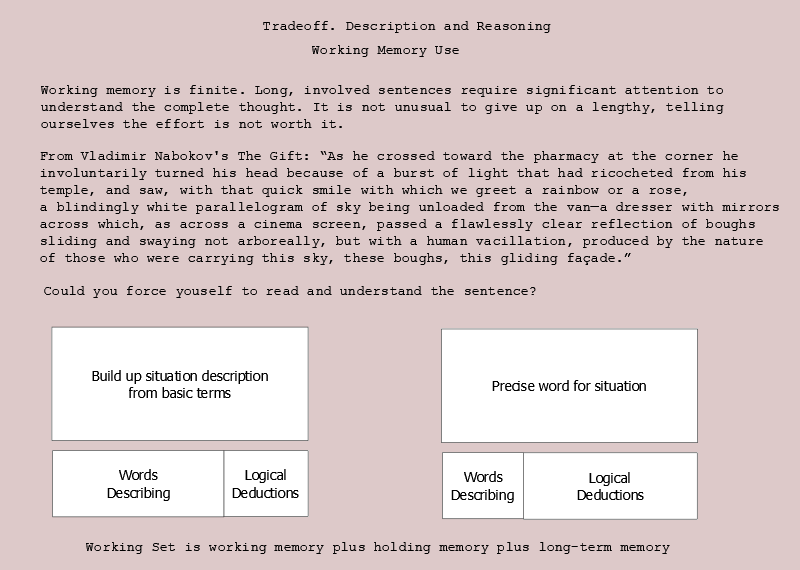Although our memory may seem to have nearly infinite capacity, our conscious attention has a significant bottleneck, working memory.
Working memory is a term for information we can bring under conscious examination, as when we try to grasp a problem. Researchers find that we do not have unlimited working memory. Torkel Klingberg in The Overflowing Brain – Information Overload and the Limits of Working Memory reports that between 5 and 9 is the typical range of items that humans can attend to at the same time. The exact number is not the important takeaway. The fact that our conscious consideration is limited and relatively small is significant.
Power of Vocabulary
It struck me in college that introductory courses were predominately organized to build up the specialized vocabulary unique to the subject. I discovered I could use fewer words to describe situations that arise in the area. Why does that teaching technique underlie so many academic subjects?
Because an immediate consequence of limited working memory is a trade-off between space devoted to description and remaining capacity to draw logical conclusions.
If we only have basic words, then describing a complex situation takes more words. Those extra words take up space that reasoning also uses. Ergo, using simpler words for complex cases leaves less capacity for logic and deeper reasoning of the complex situation is thwarted.

Precise words impose lesser requirements on working memory to describe, leaving more working memory for reasoning. General terms require more working memory to description, leaving less space for reasoning.
Reasoning by Non-Logical Processing
This section title is not a mistake. Reasoning by non-logical processing is not impossible. We do it all the time. It is based not on words and logic, but on patterns and associations. This processing occurs in the non-dominant hemisphere where, instead of words and taught concepts, we organize situations and concepts by shared features, in accord with our personal experiences. Free association is a common occurrence which leads our thoughts through association rather than logical deduction.
Before we go further, let’s not think thought trains are exclusively deductive or associative. The progress of thoughts (both logical and associative) have a regular exchange between the hemispheres. The corpus callosum allows the most productive (verbal or pattern) to be transferred to the thought stream of the other hemisphere.
An important delimiter between the two hemisphere is the verbal thought stream is heavily weighted by cultural value and academic theories that are incorporated in language. The pattern thought stream relies more heavily on personalized experiences.
Above, I used the verbal thought stream to explain the working storage trade-off. A similar trade-off occurs in the pattern-processing hemisphere. This case is most noticeable on the situation description by personal patterns and number of associations. If a situation is novel and complex with respect to your experience, there will be little space remaining for associations to be triggered.
Working Memory In Situ
In the Working Memory schematic below, the central role of working memory is displayed. Working memory exists in the frontal lobe where reasoning and decision-making takes place. Although various intermediate sensory storage areas (In Your Memory, A User’s Guide Alan Baddeley labels them visual, auditory, and haptic sensory registers) exist in the other lobes, the registers are restricted to making sensory information appear continuous. They do not contribute themselves to conscious processes.

Takeaway
There are two steps we can take to get best advantage of working memory.
- Learn precise terms relevant to areas you desire to think carefully about. This will help you keep as much working memory available for reasoning as possible.
- Get as much raw experience in subjects you care about as possible. This will enable your needs, desires, and fears to be more fully incorporated into patterns, so that associations to similar patterns have room to emerge.
Mental Construction Model, demands on the brain, hemisphere interactions, and scientific method, the rational interplay between induction and deduction.
